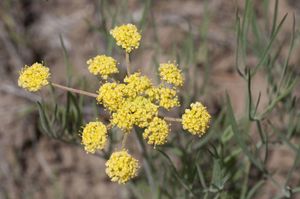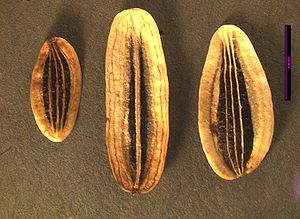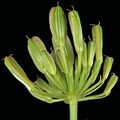Difference between revisions of "Lomatium triternatum"
(→Distribution) |
(→Photo Gallery) |
||
| (18 intermediate revisions by 4 users not shown) | |||
| Line 1: | Line 1: | ||
| − | + | * Scientific Name: ''Lomatium'' ''triternatum'' | |
| − | Lomatium triternatum | + | * Family: Apiaceae |
| − | + | * Common Names: triternate biscuit-root | |
| + | * Codon: LOMTR I | ||
| + | ---- | ||
| + | [[File:LOMTRI1.jpg |thumb|Photo by Ray Izumi, 2010, also featured on Main Page]] | ||
===Taxonomy=== | ===Taxonomy=== | ||
| − | + | {{Taxobox | |
| − | + | | image = | |
| − | + | | image_caption = Photo by Ray Izumi, 2010, also featured on Main Page | |
| − | + | | name = | |
| − | + | | regnum = [[Plant]]ae | |
| − | + | | subregnum = Viridiplantae | |
| − | + | | phylum = Tracheophyta | |
| − | + | | subphylum= Spermatophytina | |
| − | + | | classis = Magnoliopsida | |
| − | + | | subclassis = Asteranae | |
| + | | ordo = Apiales | ||
| + | | familia = Apiaceae | ||
| + | | genus = '''''Lomatium''''' Raf. | ||
| + | | species = ''''' Lomatium triternatum''''' (Pursh) J.M. Coult. & Rose | ||
| + | | subspecies = | ||
| + | }} | ||
| + | <ref>Integrated Taxonomic Information System. Retrieved from https://www.itis.gov/servlet/SingleRpt/SingleRpt?search_topic=TSN&search_value=29754</ref> | ||
===Plant Description=== | ===Plant Description=== | ||
| + | '''For the ''Lomatium'' genus, mature fruit shape, aspect ratio, and pedicel length are diagnostic.'''<ref name=":0">Hitchcock, C. L., Cronquist, A., Giblin, D., & Legler, | ||
| + | B. et al. (2018). ''Flora of the Pacific Northwest: an illustrated manual''. | ||
| + | Seattle: University of Washington Press.</ref> | ||
| − | + | Native taprooted perennial herb, growing up to 8 dm tall, glabrous to finely hairy.<ref name=":1">Bowcutt, F., & Hamman, Sarah. (2016). ''Vascular plants | |
| + | of the South Sound prairies'' (First ed.). Olympia, Washington: The Evergreen | ||
| + | State College Press.</ref><ref name=":2">Lincoln Constance & Margriet Wetherwax 2017, ''Lomatium triternatum'', in Jepson Flora Project (eds.) ''Jepson eFlora'', Revision 5, /eflora/eflora_display.php?tid=31469, accessed on June 08, 2020.</ref> | ||
| − | + | Leaves are mostly basal or lower cauline, ternately to ternately-pinnately compound, leaflets linear to lanceolate-ovate.<ref name=":3">Klinkenberg, Brian. (Editor) 2020. ''E-Flora BC: Electronic Atlas of the Plants of | |
| + | British Columbia'' [eflora.bc.ca]. Lab for Advanced Spatial Analysis, | ||
| + | Department of Geography, University of British Columbia, Vancouver. [Accessed: 2020-06-08 12:03:17 PM ]</ref><ref name=":2" /> | ||
| − | + | Inflorescence of compound umbels, corollas yellow, spokes of the umbel of unequal lengths, 2-10 cm long; involucels present.<ref name=":3" /> | |
| − | + | Fruit +- 8-10 mm x +-3-5.5mm, elliptical, mature ribs glabrous to minutely hairy.<ref name=":0" /><ref name=":3" /> | |
| − | + | ||
| − | == | + | |
| − | + | ||
| − | + | ||
| − | + | ||
===Bloom Period=== | ===Bloom Period=== | ||
| − | April to July <ref> | + | April to July <ref name="Burke">WTU Herbarium, Burke Museum, |
| + | & University of Washington. Retrieved from <nowiki>https://biology.burke.washington.edu/herbarium/imagecollection/taxon.php?Taxon=Lomatium%20triternatum</nowiki></ref> | ||
===Distribution=== | ===Distribution=== | ||
| − | + | Southern Alberta and southern BC southward to northwest Montana, central Idaho, and throughout eastern Oregon and the sagebrush steppe of eastern Washington, prairies in south Puget Sound.<ref name=":0" /><ref name=":1" /> | |
===Habitat=== | ===Habitat=== | ||
| + | |||
| + | Dry, open slopes and grasslands in the lowland, steppe, and montane zones.<ref>Klinkenberg, Brian. (Editor) 2020. ''E-Flora BC: Electronic Atlas of the Plants of British Columbia'' [eflora.bc.ca]. Lab for Advanced Spatial Analysis, Department of Geography, University of British Columbia, Vancouver. [Accessed: 2020-06-08 4:10:24 PM]</ref> | ||
===Uses=== | ===Uses=== | ||
| + | Many ''Lomatiums'' are important food plants. | ||
| + | |||
| + | Sx̌ʷyʔiɬpx use of dried flowers and upper leaves as flavoring for stews and other foods, also dried flowers and leaves taken for colds and sore throats. | ||
| + | |||
| + | Atsugewi use of roots as food, cooked in earth oven.<ref>Native American Ethnobotany Database. Retrieved from <nowiki>http://naeb.brit.org/uses/search/?string=Lomatium+triternatum</nowiki></ref> | ||
===Propagation=== | ===Propagation=== | ||
| + | Seed matures in July or August. Seed disarticulates easily from stems. | ||
| − | + | Requires extensive stratification, fall dormant seeding preferred. | |
| − | + | ||
| − | + | ||
| − | + | ||
| − | + | ||
| − | + | ||
| − | + | ||
| − | + | ||
| − | + | ||
| − | </ref> | + | Above-ground growth is slow, as plant establishes taproot. Many plants will not produce flowers and fruits in the first few years.<ref>Tilley, Derek; St. John, Loren.; Ogle, Dan.; Shaw, Nancy.; Cane, Jim. 2012. Propagation protocol for production of Lomatium triternatum (Pursh) Coulter & Rose seeds; USDA NRCS - Aberdeen Plant Materials Center, Aberdeen, Idaho. In: Native Plant Network. URL: <nowiki>http://www.nativeplantnetwork.org</nowiki> (accessed 4 April 2012). Moscow (ID): University of Idaho, College of Natural Resources, Forest Research Nursery.</ref> |
===Seed=== | ===Seed=== | ||
| − | + | [[File:Lomatium triternatum.jpg|300px|thumb|''Lomatium triternatum,'' photo by Lisa Hintz]] | |
| − | [[File:Lomatium triternatum.jpg|300px|thumb | + | |
| − | + | ||
| − | + | ||
'''Seed sample from:''' 2011 | '''Seed sample from:''' 2011 | ||
| Line 81: | Line 91: | ||
{{Basics}} | {{Basics}} | ||
| + | |||
| + | === Photo Gallery === | ||
| + | <gallery> | ||
| + | File:LOMTRI2.jpg| photo by Rod Gilbert, 2005 | ||
| + | File:LOMTRI3.jpg| in fruit, photo by Robert L. Carr, 2011 | ||
| + | File:LOMTRI4.jpg| mature fruit, photo by Craig Althen, 2010 | ||
| + | File:LOTR BeccaReilly sdl good.JPG|Young growth, courtesy CNLM | ||
| + | File:LOMTRI5.jpg|courtesy CNLM | ||
| + | </gallery> | ||
| + | |||
===References=== | ===References=== | ||
| − | + | ||
| − | < | + | <references /> |
Latest revision as of 09:25, 21 March 2021
- Scientific Name: Lomatium triternatum
- Family: Apiaceae
- Common Names: triternate biscuit-root
- Codon: LOMTR I
Contents
Taxonomy
| Scientific classification | |
|---|---|
| Kingdom: | Plantae |
| Subkingdom: | Viridiplantae |
| Phylum: | Tracheophyta |
| Subphylum: | Spermatophytina |
| Class: | Magnoliopsida |
| Subclass: | Asteranae |
| Order: | Apiales |
| Family: | Apiaceae |
| Genus: | Lomatium Raf. |
| Species: | Lomatium triternatum (Pursh) J.M. Coult. & Rose |
Plant Description
For the Lomatium genus, mature fruit shape, aspect ratio, and pedicel length are diagnostic.[2]
Native taprooted perennial herb, growing up to 8 dm tall, glabrous to finely hairy.[3][4]
Leaves are mostly basal or lower cauline, ternately to ternately-pinnately compound, leaflets linear to lanceolate-ovate.[5][4]
Inflorescence of compound umbels, corollas yellow, spokes of the umbel of unequal lengths, 2-10 cm long; involucels present.[5]
Fruit +- 8-10 mm x +-3-5.5mm, elliptical, mature ribs glabrous to minutely hairy.[2][5]
Bloom Period
April to July [6]
Distribution
Southern Alberta and southern BC southward to northwest Montana, central Idaho, and throughout eastern Oregon and the sagebrush steppe of eastern Washington, prairies in south Puget Sound.[2][3]
Habitat
Dry, open slopes and grasslands in the lowland, steppe, and montane zones.[7]
Uses
Many Lomatiums are important food plants.
Sx̌ʷyʔiɬpx use of dried flowers and upper leaves as flavoring for stews and other foods, also dried flowers and leaves taken for colds and sore throats.
Atsugewi use of roots as food, cooked in earth oven.[8]
Propagation
Seed matures in July or August. Seed disarticulates easily from stems.
Requires extensive stratification, fall dormant seeding preferred.
Above-ground growth is slow, as plant establishes taproot. Many plants will not produce flowers and fruits in the first few years.[9]
Seed
Seed sample from: 2011
Average Measurement: 9.5 x 3.3 x 1
Measurement Range: L: 7.25 - 12.5, W: 3 - 4, D: 0.5 - 1.5
Features
Shape: Seed a schizocarp, winged, laterally compressed, and ribbed.
Color: On one seed face, there are three white ribs that run across a dark reddish brown surface. On the opposite seed face there is one rib that bisects the dark brown.
Surface: Seeds are matte.
Latitudinal Cross Section: rhombic ![]()
Longitudinal Cross Section: elliptical ![]()
Basic Explanations and Assumptions:
The dimensions for the seeds are length x width x depth. The location of the hilum is used as the base of the seed, and the length is measured from hilum to the opposite apex. Where a style is present, the length is measured from the hilum to the bottom of the style. Width is measured at a right angle to the length at the widest part. Depth is measured at a right angle to the intersection of height and width lines.
Measurements included are the mean average for each measurement of ten separate seeds.
All measurements in millimeters unless otherwise noted.
Photo Gallery
References
- ↑ Integrated Taxonomic Information System. Retrieved from https://www.itis.gov/servlet/SingleRpt/SingleRpt?search_topic=TSN&search_value=29754
- ↑ 2.0 2.1 2.2 Hitchcock, C. L., Cronquist, A., Giblin, D., & Legler, B. et al. (2018). Flora of the Pacific Northwest: an illustrated manual. Seattle: University of Washington Press.
- ↑ 3.0 3.1 Bowcutt, F., & Hamman, Sarah. (2016). Vascular plants of the South Sound prairies (First ed.). Olympia, Washington: The Evergreen State College Press.
- ↑ 4.0 4.1 Lincoln Constance & Margriet Wetherwax 2017, Lomatium triternatum, in Jepson Flora Project (eds.) Jepson eFlora, Revision 5, /eflora/eflora_display.php?tid=31469, accessed on June 08, 2020.
- ↑ 5.0 5.1 5.2 Klinkenberg, Brian. (Editor) 2020. E-Flora BC: Electronic Atlas of the Plants of British Columbia [eflora.bc.ca]. Lab for Advanced Spatial Analysis, Department of Geography, University of British Columbia, Vancouver. [Accessed: 2020-06-08 12:03:17 PM ]
- ↑ WTU Herbarium, Burke Museum, & University of Washington. Retrieved from https://biology.burke.washington.edu/herbarium/imagecollection/taxon.php?Taxon=Lomatium%20triternatum
- ↑ Klinkenberg, Brian. (Editor) 2020. E-Flora BC: Electronic Atlas of the Plants of British Columbia [eflora.bc.ca]. Lab for Advanced Spatial Analysis, Department of Geography, University of British Columbia, Vancouver. [Accessed: 2020-06-08 4:10:24 PM]
- ↑ Native American Ethnobotany Database. Retrieved from http://naeb.brit.org/uses/search/?string=Lomatium+triternatum
- ↑ Tilley, Derek; St. John, Loren.; Ogle, Dan.; Shaw, Nancy.; Cane, Jim. 2012. Propagation protocol for production of Lomatium triternatum (Pursh) Coulter & Rose seeds; USDA NRCS - Aberdeen Plant Materials Center, Aberdeen, Idaho. In: Native Plant Network. URL: http://www.nativeplantnetwork.org (accessed 4 April 2012). Moscow (ID): University of Idaho, College of Natural Resources, Forest Research Nursery.







